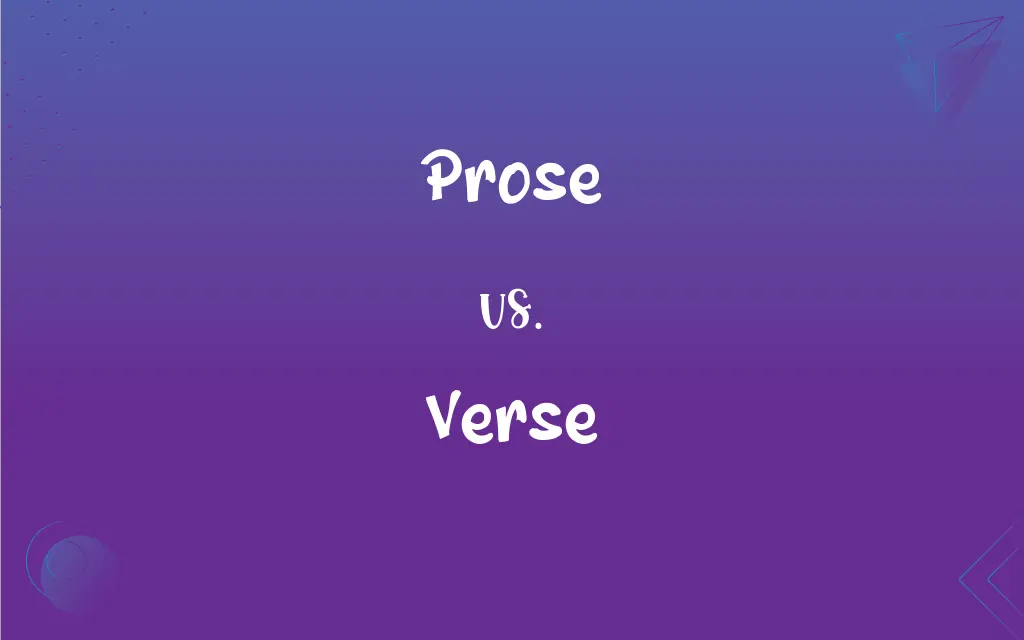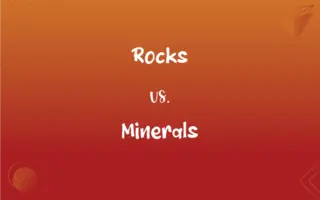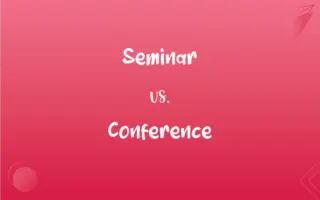Prose vs. Verse: What's the Difference?
Edited by Aimie Carlson || By Harlon Moss || Updated on October 16, 2023
Prose is ordinary written language without metrical structure, while verse is structured writing with rhythm and often rhyme.

Key Differences
Prose is a form of language that conveys thoughts and ideas in a straightforward manner, often mirroring natural speech. Verse, on the other hand, is a poetic form that employs rhythm, meter, and sometimes rhyme, creating a more structured expression.
In literature, prose can be found in novels, essays, and articles where the emphasis is on clarity and directness. Verse is commonly seen in poems and songs, emphasizing aesthetic and rhythmic qualities to evoke emotions.
Prose doesn't adhere to specific patterns or rhythms, giving writers flexibility in expression and structure. In contrast, verse follows specific patterns, be it in terms of syllables, stresses, or rhyme schemes, which can amplify the intended message or emotion.
When reading prose, the audience often seeks clear information, engaging stories, or compelling arguments. With verse, readers or listeners might be looking for a rhythmic experience, emotional resonance, or the beauty of the language.
From a historical perspective, prose has been the go-to for factual, logical, or narrative content, while verse has been favored for artistic, spiritual, or emotional expressions.
ADVERTISEMENT
Comparison Chart
Structure
Lacks specific metrical structure.
Contains structured rhythm, often with rhyme.
Primary Use
Novels, essays, articles.
Poems, songs.
Flexibility
Offers flexibility in expression.
Follows specific patterns and structures.
Reader Expectation
Clarity, directness, information.
Rhythmic experience, emotional resonance.
Historical Use
Factual, logical, or narrative content.
Artistic, spiritual, emotional expressions
ADVERTISEMENT
Prose and Verse Definitions
Prose
Prose is ordinary written or spoken language without a metrical structure.
Novels are typically written in prose.
Verse
Verse is a form of writing that employs rhythm, and often rhyme, to convey meaning.
Shakespeare's sonnets are classic examples of verse.
Prose
Prose prioritizes clarity and direct communication.
News articles are written in prose to provide straightforward information.
Verse
Verse is commonly used for artistic and poetic expression.
Many ancient cultures passed down their histories and myths through verse.
Prose
Prose mirrors natural speech in its flow and structure.
The dialogue in plays is often written in prose to reflect everyday conversation.
Verse
Verse adheres to specific metrical patterns, creating structured expressions.
The national anthem is written in verse, evoking patriotism through its rhythm.
Prose
Prose can be either fiction or non-fiction, encompassing a wide range of literary works.
Biographies, written in prose, detail the life stories of individuals.
Verse
Verse is often found in songs, poems, and some sections of religious texts.
Hymns sung in churches are often composed in verse, praising the divine with rhythm and melody.
Prose
Prose is a form of literary expression that doesn't adhere to rhythmic patterns.
Essays utilize prose to convey information clearly.
Verse
Verse can intensify emotions through its rhythmic qualities.
Romantic poets like Keats and Shelley employed verse to explore deep emotional themes.
Prose
Ordinary speech or writing, without metrical structure.
Verse
A single metrical line in a poetic composition; one line of poetry.
Prose
Commonplace expression or quality.
Verse
A division of a metrical composition, such as a stanza of a poem or hymn.
FAQs
Are all poems written in verse?
While most traditional poems employ verse, there are prose poems that utilize the characteristics of prose.
What is prose?
Prose is ordinary written or spoken language without a specific metrical structure.
How does verse differ from prose?
Verse employs rhythm, often with rhyme, whereas prose lacks a structured meter.
Is prose more flexible than verse?
Yes, prose offers more flexibility in expression as it doesn't adhere to rhythmic patterns like verse.
Can prose be poetic?
While prose lacks the metrical structure of verse, it can still be poetic in its imagery and expression.
Is verse limited to poems?
No, verse can also be found in songs, hymns, and sections of religious texts.
Does prose resemble everyday speech?
Yes, prose mirrors the flow and structure of natural speech.
Can verse be used in plays?
Yes, many classical plays, like those by Shakespeare, use verse for dialogues and monologues.
Why might a writer choose prose over verse?
Prose is often chosen for clarity, direct communication, and flexibility, especially in narrative or informative works.
Are novels written in prose?
Typically, yes. Novels are primarily written in prose.
Can prose be rhythmic?
While prose doesn't have a set metrical structure like verse, it can still possess a natural rhythm.
Does prose prioritize clarity?
Yes, prose often prioritizes clarity and directness in communication.
Can verse be found in religious texts?
Yes, many religious texts incorporate verse for prayers, hymns, or specific teachings.
What's the main appeal of verse?
Verse offers an aesthetic and rhythmic experience, amplifying emotions and artistic expression.
Can verse be without rhyme?
Yes, verse can be unrhymed but still have a rhythmic structure.
What emotions can verse evoke?
Verse, through its rhythm and rhyme, can intensify emotions, whether joy, sorrow, love, or any other feeling.
Is prose limited to fiction?
No, prose encompasses both fiction and non-fiction, including essays, articles, and biographies.
Which is more structured: prose or verse?
Verse is more structured due to its rhythmic and often rhyming patterns.
Why is verse used in songs?
Verse's rhythmic qualities make it suitable for musical compositions and expressions in songs.
Is prose more common than verse in modern literature?
Prose dominates in many modern literary forms like novels and essays, but verse remains prevalent in poetry and songs.
About Author
Written by
Harlon MossHarlon is a seasoned quality moderator and accomplished content writer for Difference Wiki. An alumnus of the prestigious University of California, he earned his degree in Computer Science. Leveraging his academic background, Harlon brings a meticulous and informed perspective to his work, ensuring content accuracy and excellence.
Edited by
Aimie CarlsonAimie Carlson, holding a master's degree in English literature, is a fervent English language enthusiast. She lends her writing talents to Difference Wiki, a prominent website that specializes in comparisons, offering readers insightful analyses that both captivate and inform.































































